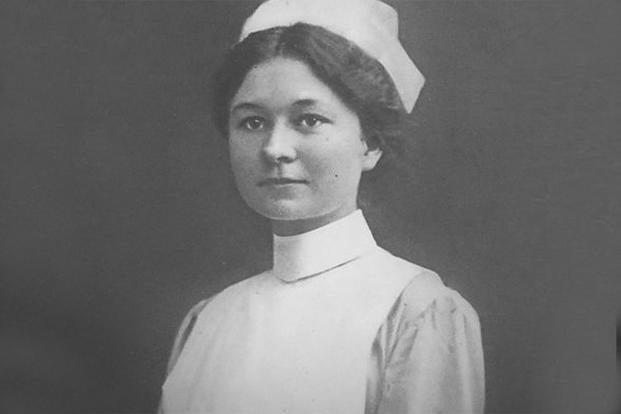"Oh, the stories I'll tell when I get home," Army nurse Helen Fairchild wrote to her family in 1917.
Fairchild was one of 64 nurses from Pennsylvania Hospital Unit #10 who had volunteered to join the American Expeditionary Force after the United States entered World War I on April 6, 1917. She was not destined to tell the stories she mentioned. Nurse Fairchild died on Jan. 8, 1918, while on duty with British Base Hospital #10/#16.
Yet her letters home provide a window into a period of Nurse Corps service that is often misunderstood, and carry her story across miles and years. Fairchild spent most of her active-duty time in the Ypres-Passchendaele area at Casualty Clearing Station #4. If the base hospital, where the 64 volunteers faced 2,000 beds, had seemed daunting, the Casualty Clearing Stations must have seemed even more so. In August 1917, Fairchild wrote to her mother: "We all live in tents and wade through mud to and from the operating room where we stand in mud higher than our ankles."
Chief Nurse Julia Stimson, who remained at the Base Hospital, was concerned for her nurses who went to the casualty clearing stations, but knew they were strong. She wrote of all that they endured: "What with the steam, the ether ... the odor in the operating room ... sewing and tying up and putting in drains while the doctor takes the next piece of shell out ... Then after fourteen hours of this ... off to rest if you can ... one need never tell me that women can't do as much, stand as much, and be as brave as men."
Nelle Fairchild Rote, Helen's niece, agrees. "I knew my father was so proud of his sister's service," Rote said. "When schoolboys told me my aunt didn't count as a soldier because she was a girl, I was stung. How could anyone say she was not a veteran, too?"
Rote calls her aunt "my hero" and has been collecting information about Fairchild's unit, colleagues and wartime experiences. Her efforts have been rewarding. The Belgian Flanders Fields Museum includes Fairchild in their exhibit. She is also spotlighted in a brochure on gas warfare in the Belgian town of Poperinghe.
Despite this latter tribute, no one can say for sure whether Fairchild's death was due to complications from chloroform used during surgery for a stomach ulcer a few days before she died, or from effects of mustard gasses, which mimic the effects chloroform has on the stomach. Mustard gas was used during the heavy shelling in the area from July 15-25, 1917, and Fairchild certainly went to the front on July 22, seven days before the start of the Third Battle of Ypres-Passchendaele.
Rote will continue to research, and the contacts she makes in the course of her inquiries remind her of how important it is to put faces to the names of these brave battlefield nurses. A few years ago, she received a letter from a nurse who was then a captain in the U.S. Air Force. "Helen's story reached across the years and spoke to the very moment in which I was training," wrote Lynn Nicklas Stepaniak. "Her story portrays the purest form of sacrifice." The young nurse Helen Fairchild, who would have "books to tell" when she returned home, still inspires by her example.
Want to Know More About the Military?
Be sure to get the latest news about the U.S. military, as well as critical info about how to join and all the benefits of service. Subscribe to Military.com and receive customized updates delivered straight to your inbox.















